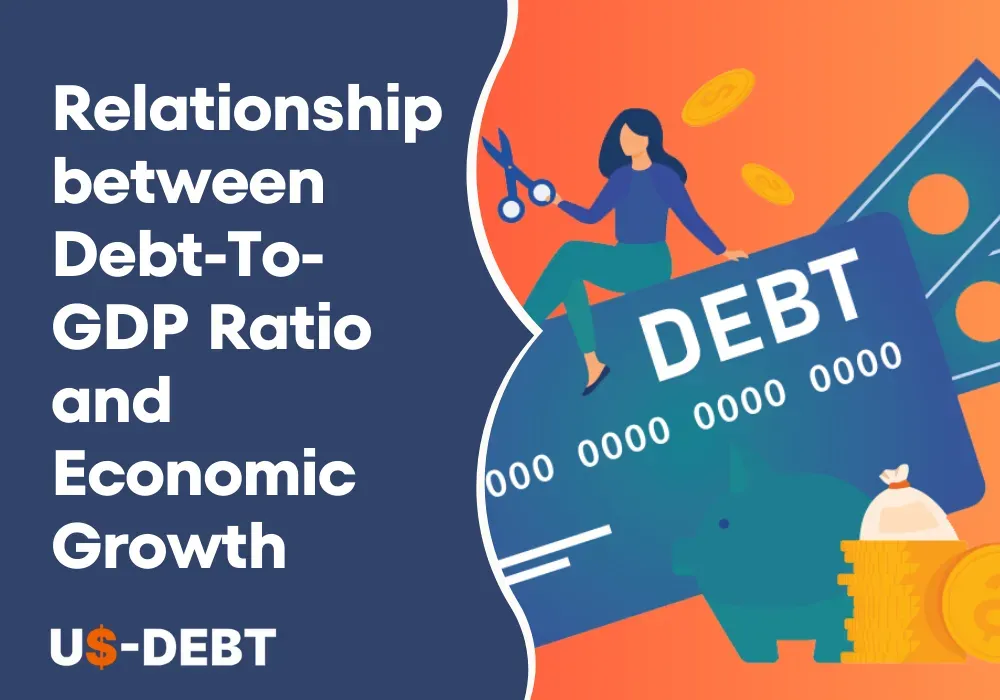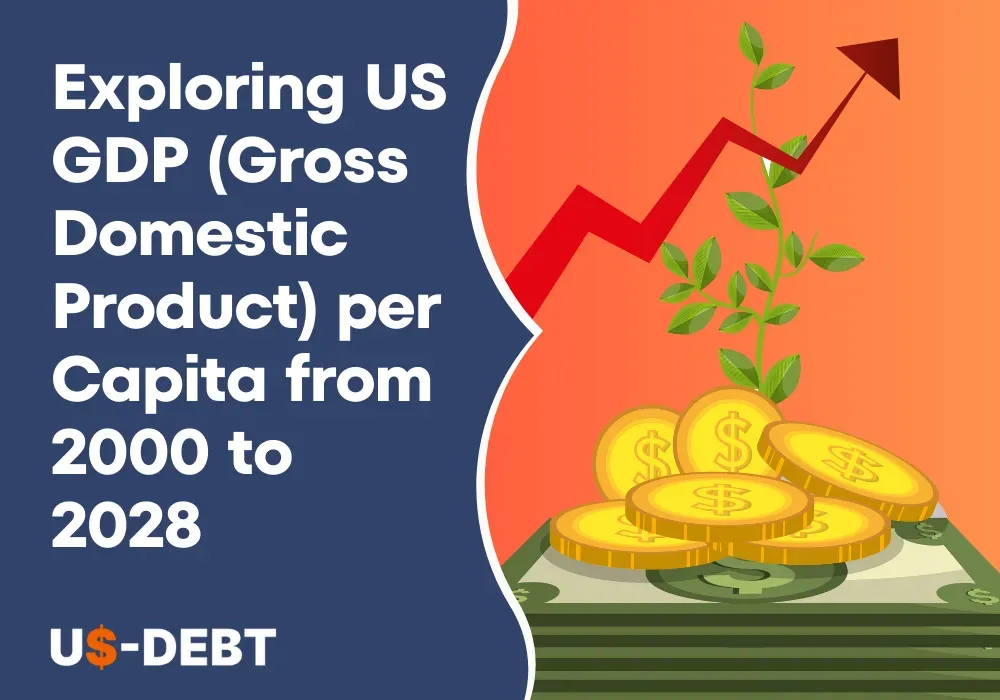The consequence of the debt-to-GDP ratio on economic growth is complicated and contextual. While high levels of debt close to GDP can burden an economy with interest payments and hinder investment, moderate levels of debt can encourage growth by funding public investments and infrastructure development. Therefore, discovering a proper balance is essential, as it guarantees sustainable economic growth while strengthening fiscal resilience and debt sustainability. The definition, computation, and importance of the debt-to-GDP ratio for economic growth will all be discussed in this blog.
Â
Understanding Debt-To-GDP Ratio
Debt-to-GDP ratio is an important economic metric, which helps to get insights into a country's economic health and the capability to face its liabilities. To comprehend this ratio is vital for the general public and professionals alike.
The relationship between a nationâs debts concerning its Gross Domestic Product (GDP) is estimated by the debt-to-GDP ratio. It is expressed as a percentage and indicates the size and sustainability of a nation's debt burden. It simply compares a country's total debt to its economic production to decide the ratio of debt to the size of an economy.
Â
Calculation and Interpretation
The entire debt of a nation is divided by its GDP, and the resulting number is multiplied by 100 to indicate the ratio as a percentage. The formula for calculating the Debt-to-GDP ratio is ((Total debt / GDP) * 100)
In addition to public and governmental liabilities under the header of Total Debt, one can also consider at times financial obligations from private companies. Moreover, GDP demonstrates how much an economy has produced in terms of goods and services within its confines over a certain time frame.
The magnitude and historical revolution of the debt-to-GDP ratio must be taken into account while analyzing it. A higher ratio implies that a country has a larger debt burden relative to its economic output, indicating potential fiscal challenges. Conversely, a lower ratio suggests a more manageable debt burden.
Â
Factors Affecting Debt-To-GDP Ratio
Government Spending and Budget Deficits: The debt-to-GDP ratio may rise as a result of increased public spending and ongoing budget deficits. Governments borrow when their expenses are more than their income, which increases their debt load.
Economic Growth: The ratio of debt to GDP can be lowered with strong economic development. The ratio's denominator rises with GDP growth, reducing the ratio's relative debt load. A strong economy brings in more tax income, which lowers the demand for borrowing.
Interest Rates: The debt-to-GDP ratio is impacted by changes in interest rates. The cost of repaying debt increases when interest rates rise, thereby pushing up the ratio. In contrast, lower interest rates can reduce the burden of debt and lower the ratio.
Fiscal Discipline and Structural Reforms: Implementing prudent fiscal policies, including controlling government expenditures and increasing revenue sources, can help maintain a sustainable debt-to-GDP ratio. Structural reforms aimed at enhancing productivity, efficiency, and competitiveness can also positively influence the ratio by promoting economic growth.
Economic Shocks and Crises: Economic downturns, financial crises, or external shocks can significantly impact the debt-to-GDP ratio. These events may lead to increased borrowing to stimulate the economy or address financial instability, resulting in a higher debt burden.
Â
Relationship between Debt-To-GDP Ratio and Economic Growth
It is always a topic of conversation for professionals and the general public about the relationship between economic growth respects to the debt-to-GDP ratio. We may obtain a thorough grasp of how the debt-to-GDP ratio affects economic growth by comprehending these factors.
Â
Theoretical Perspectives
Debt-Led Growth Hypothesis: The debt-led growth hypothesis suggests that in some cases, an increase in the debt-to-GDP ratio can stimulate economic growth. Proponents of this theory argue that borrowing and subsequent government spending can spur economic activity, creating a positive multiplier effect. Yet, there is a controversy concerning the sustainability and long-term consequences of debt-led growth.
Crowding-Out Effect: The crowding-out effect suggests that a high debt-to-GDP ratio can have detrimental effects on economic growth. According to this theory, extreme government borrowing can lead to higher interest rates, which may crowd out private investment. This crowding-out effect can hinder economic growth by reducing private sector activity and dampening investment in productive sectors.
Sustainability of Debt: The sustainability of debt refers to a country's ability to service its debt obligations without risking a fiscal crisis. Problems regarding the sustainability of debt emerge when the debt-to-GDP ratio exceeds a specific level. Unsustainable debt levels can have a detrimental effect on economic development, raise borrowing prices, and increase the danger of default.
Â
Empirical Studies and Findings
Case Studies: Numerous case studies have explored the relationship between the debt-to-GDP ratio and economic growth in specific countries. These studies examine historical data to assess the impact of debt levels on economic performance. Researchers have discovered important lessons about the link between debt-to-GDP ratios and growth by examining issues including debt management techniques, fiscal policies, and economic consequences.
Cross-Country Analysis: Cross-country analysis involves comparing debt-to-GDP ratios and economic growth across different nations. By examining a wide range of countries with varying economic conditions, policies, and debt levels, researchers can identify patterns and trends in the relationship. These types of research provide valuable insight into the debt-to-GDP ratio that might affect economic growth entirely.
Â
Factors Influencing the Relationship
Government Policy and Fiscal Discipline: Sound fiscal policies, including prudent spending, efficient revenue generation, and responsible debt management, play a crucial role in determining the relationship between debt-to-GDP ratios and economic growth. Governments that prioritize fiscal discipline can create an environment conducive to sustainable growth, as they manage their debt burden effectively.
Institutional Factors: The relationship between the debt-to-GDP ratio and economic growth is affected by institutional factors such as the rule of law, the quality of governance, and transparency. Strong institutions foster investor confidence, attract foreign direct investment, and promote economic stability, which can mitigate the negative impact of high debt levels.
External Factors: It is also noticed that the relationship between the debt-to-GDP ratios and economic growth is also affected by some external factors like exchange rate dynamics, global economic situations, and access to international financial markets. Overall economic performance, the nation's borrowing costs, and cash flow might be seriously impacted by several economic shocks, changes in market sentiment, or financial crises.
Â
Importance of the Debt-To-GDP Ratio for Economic Growth
Fiscal Sustainability: The debt-to-GDP ratio provides insights into a country's ability to manage its debt burden effectively. High levels of debt relative to GDP can signal potential financial risks and an increased likelihood of default. By monitoring and managing this ratio, policymakers can ensure fiscal sustainability and reduce the risk of economic instability.
Investor Confidence: A low debt-to-GDP ratio is often viewed as a positive signal by investors and credit rating agencies. It suggests that a nation has a decreased chance of failing to make debt payments, which makes it a desirable location for foreign investments. Investor confidence can boost capital inflows, stimulate economic growth, and create employment opportunities.
Fiscal Space: Maintaining a reasonable debt-to-GDP ratio allows governments to have sufficient fiscal space during economic downturns or emergencies. It allows for the implementation of countercyclical policies like higher public expenditure or tax breaks to boost the economy, avoid recessions, and fund social welfare initiatives.
Interest Rates and Borrowing Costs: The debt-to-GDP ratio can influence a country's borrowing costs and interest rates. A higher ratio may lead to higher interest rates, as lenders demand a risk premium to compensate for potential default risk. Increased borrowing costs can crowd out private investment and hinder economic growth. Thus, managing and decreasing the debt-to-GDP ratio can help maintain favorable borrowing conditions and lower interest payments.
Long-Term Growth Potential: Excessive debt levels can hamper a country's long-term economic growth prospects. Elevated debt-to-GDP ratios can shift resources away from productive investments and infrastructure development. By maintaining the ratio within a bearable range, governments can prioritize investments in education, healthcare, research and development, and other sectors that encourage long-term growth.
Â
Conclusion
There are numerous aspects related to and influencing the debt-to-GDP ratio and economic growth interaction. Theoretical viewpoints argue the merits of debt-driven growth versus the crowding-out effect, while empirical research and case studies shed light on the experiences of particular nations. It is obvious that stable debt levels, backed by wise governmental decisions and budgetary restraint, are necessary to promote economic growth.
The growth of this relationship is also significantly influenced by institutional components and environmental factors. The link between controlling the debt-to-GDP ratio and fostering economic growth must be balanced, and this requires a supportive institutional framework in addition to competent debt management and cautious decision-making. It is critical to thrash a proportion between controlling the debt-to-GDP ratio and fostering economic growth. This may be done by creating a supportive institutional framework, managing debt effectively, and making wise decisions.
Â
You May Also Like:

